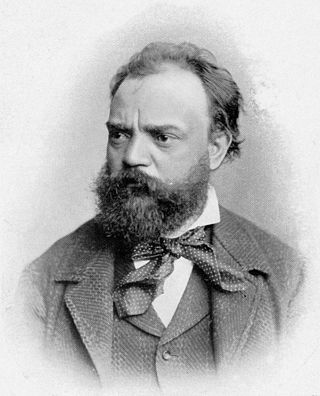
A symphony is an extended musical composition in Western classical music, most often for orchestra. Although the term has had many meanings from its origins in the ancient Greek era, by the late 18th century the word had taken on the meaning common today: a work usually consisting of multiple distinct sections or movements, often four, with the first movement in sonata form. Symphonies are almost always scored for an orchestra consisting of a string section, brass, woodwind, and percussion instruments which altogether number about 30 to 100 musicians. Symphonies are notated in a musical score, which contains all the instrument parts. Orchestral musicians play from parts which contain just the notated music for their own instrument. Some symphonies also contain vocal parts.

The Pulitzer Prize for Music is one of seven Pulitzer Prizes awarded annually in Letters, Drama, and Music. It was first given in 1943. Joseph Pulitzer arranged for a music scholarship to be awarded each year, and this was eventually converted into a prize: "For a distinguished musical composition of significant dimension by an American that has had its first performance in the United States during the year."

William Grant Still Jr. was an American composer of nearly two hundred works, including five symphonies, four ballets, nine operas, over thirty choral works, art songs, chamber music, and solo works. Born in Mississippi and growing up in Little Rock, Arkansas, Still attended Wilberforce University and Oberlin Conservatory of Music as a student of George Whitefield Chadwick and then Edgard Varèse. Because of his close association and collaboration with prominent African-American literary and cultural figures, Still is considered to be part of the Harlem Renaissance.

The Symphony No. 5 in D major/D minor, Op. 107, known as the Reformation, was composed by Felix Mendelssohn in 1830 in honor of the 300th anniversary of the Presentation of the Augsburg Confession. The Confession is a key document of Lutheranism and its Presentation to Emperor Charles V in June 1530 was a momentous event of the Protestant Reformation. This symphony was written for a full orchestra and was Mendelssohn's second extended symphony. It was not published until 1868, 21 years after the composer's death – hence its numbering as '5'. Although the symphony is not very frequently performed, it is better known today than when it was originally published. Mendelssohn's sister, Fanny Mendelssohn Hensel, chose the name Reformation Symphony.

Steve Heitzeg is an American composer whose works include compositions for orchestra, chorus, chamber ensemble, ballet, and film.

Afro-American Symphony, also known as Symphony No. 1"Afro-American" and Symphony No. 1 in A-flat major, is a 1930 composition by William Grant Still, the first symphony written by an African American and performed for a United States audience by a leading orchestra. It was premiered in 1931 by the Rochester Philharmonic Orchestra and later published in 1935. It is a symphonic piece for full orchestra, including celeste, harp, and tenor banjo. It combines a fairly traditional symphonic form with blues progressions and rhythms that were characteristic of popular African-American music at the time. This combination expressed Still's integration of black culture into the classical forms. Still used quotes from four poems by early 20th-century African-American poet Paul Laurence Dunbar as epigraphs for each symphonic movement. The symphony is about twenty-four minutes long.
Symphony No. 2 in A major is a classical composition by American composer Douglas Moore. It was composed in 1945 and received its premiere in Paris on May 5, 1946, conducted by Robert Lawrence. In the following year the American premiere was given in Los Angeles, Alfred Wallenstein conducting.

Alireza Mashayekhi is an Iranian musician, composer, conductor and academic. He is one of the first composers in Iran to represent avant-garde and electroacoustic music.

The Symphony No. 3 in E♭ major, Op. 10, B. 34, is a classical composition by Antonín Dvořák.
Milan Ristić was a Serbian composer, and a member of the Serbian Academy of Sciences and Arts.
A Symphony of Three Orchestras is an orchestra composition by the American composer Elliott Carter. The work was commissioned by the New York Philharmonic through a grant from the National Endowment for the Arts. It was composed from June through December 1976 and was first performed in New York City on February 17, 1977 by the New York Philharmonic under the conductor Pierre Boulez. The composition is dedicated to Boulez and the New York Philharmonic.

Miniature is a musical composition in five movements composed in 1948 by American composer William Grant Still. The composition was originally created for trio and was later, in 1963, arranged for quintet. The composition is about twelve minutes long.

Symphony No. 2 in G minor, also known as Symphony No. 2"Song of a New Race", is a 1937 composition in four movements by American composer William Grant Still. The work was first performed on December 10, 1937, by the Philadelphia Orchestra led by conductor Leopold Stokowski. The symphony is about thirty minutes long.

Symphony No. 3, also known as Symphony No. 3"The Sunday Symphony", is a 1958 composition in four movements by American composer William Grant Still. The work was first performed on February 12, 1984 by the North Arkansas Symphony Orchestra conducted by Carlton Woodsi. The symphony is about eighteen minutes long.

Symphony No. 5, also known as Symphony No. 5"Western Hemisphere", is a 1945 composition in four movements by American composer William Grant Still. The work was first performed on November 9, 1970 by the Oberlin College Orchestra conducted by Robert Baustian. The symphony is about twenty minutes long.

Africa is a 1930 symphonic poem in three movements by American composer William Grant Still. The work, originally scored for chamber orchestra, was first performed in 1930 by French flautist Georges Barrère and, in a full orchestra version, by Howard Hanson on October 24, 1930, at the Eastman School of Music in Rochester, New York. The work is about twenty-eight minutes long.

The American Scene is a musical composition consisting of five orchestral suites composed in 1957 by American composer William Grant Still.

Three Visions is a 1935 suite in three parts for solo piano, and later, the second part, Summerland, for chamber orchestra, by American composer William Grant Still. According to Judith Anne Still, the composer's daughter, "The three segments of the suite, Dark Horsemen, Summerland, and Radiant Pinnacle, tell the story of the human soul after death: the body expires, and the soul goes on to an apocalyptic judgment. If it is seen that the past life has been a good one, the soul may enter “heaven,” or “Summerland”. After a period of time, the soul may reincarnate to learn additional earthly lessons on the human plane. Some souls reincarnate many times in a constant circular progress toward Godly perfection." Three Visions was composed by Still for his wife, Verna Arvey, who first played the composition in Los Angeles in 1936. The suite is about eleven minutes long.

Kaintuck' (Kentucky) is a 1935 symphonic poem for piano and orchestra by American composer William Grant Still.







